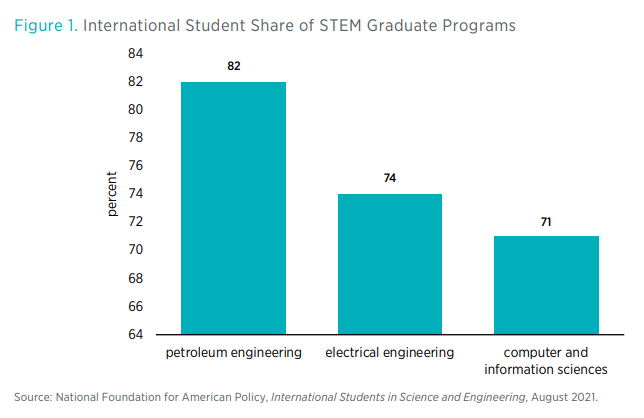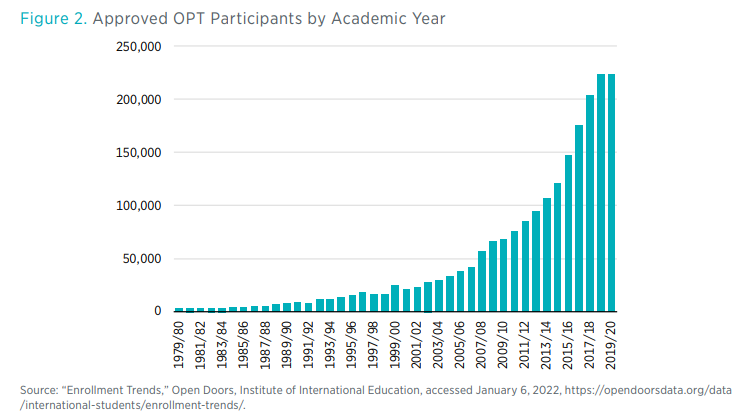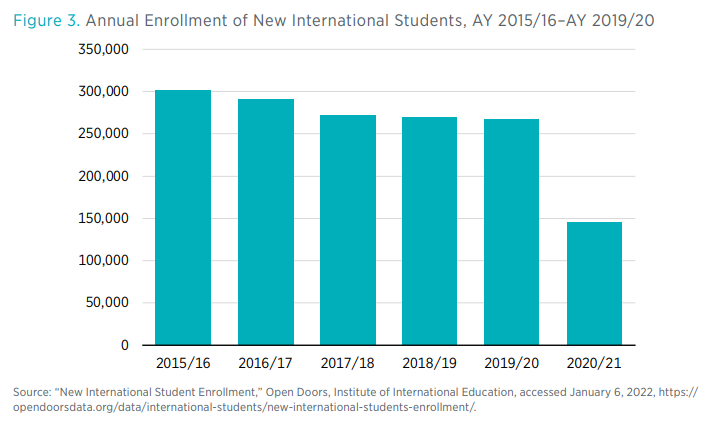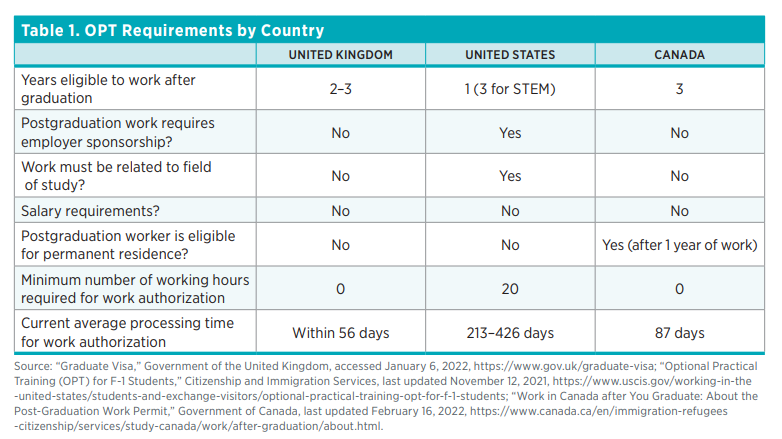- | Labor Markets Labor Markets
- | Policy Briefs Policy Briefs
- |
Reforming Optional Practical Training (OPT) to Enhance Technological Progress and Innovation
A bill introduced in the US House of Representatives seeks to terminate the Optional Practical Training (OPT) program, which allows student visa holders to work in the United States on a temporary basis upon graduation from a US university. Yet credible research studies have shown that access to skilled foreign workers accelerates innovation, productivity, and economic growth. The United States has been one of the leading recruiters of global talent, and ending the OPT program would undermine this advantage and impose costs on the American economy.
We propose bolstering the OPT program rather than undermining the United States’ edge in the global race for talent. The US Department of Homeland Security (DHS), within its statutory authority, should introduce the following reforms to the OPT program:
- Increase eligible years of work for non–science, technology, engineering, and mathematics (non-STEM) graduates on OPT from one year to three years.
- Remove employer sponsorship requirements.
- Allow foreign graduates to work in industries unrelated to their field of study.
- Eliminate minimum-working-hour requirements for employment authorization.
- Streamline the I-765 issuance process to ensure that foreign graduates can obtain Employment Authorization Documents (EADs) within three months or less.
- Exempt OPT participants from the H-1B lottery process if they have acquired at least one year of work experience.
This brief will summarize extant evidence to support this proposal.
International Students’ Outsize Contribution to STEM Fields, Patents, and Innovation
Immigrants account for 18 percent of college graduates but account for 29 percent of science and engineering college graduates and 52 percent of those earning doctorates in STEM fields. Immigrant graduates with science and engineering degrees have historically had a patent rate double the average American rate.
In academic year (AY) 2019/20, 1,075,496 international students on F-1 visas studied at US colleges and universities, representing roughly 1 in 20 college students. According to one estimate, these international students contributed $39 billion to the US economy and supported more than 416,000 jobs during the 2019/20 academic year. This estimate is obtained counting international students’ tuition and fees that supported direct jobs in higher education as well as international students’ living expenses that supported direct jobs in the areas of accommodation, food and dining, telecommunications, and transportation. On the basis of these estimates, one finds that for every dozen international students who choose to study in the United States, five domestic jobs are created either directly or indirectly, and the US economy benefits from additional spending of $435,000.
At many universities, foreign students make up a significant share of the student body, particularly in graduate programs. At universities such as Northeastern University and Columbia University, international students make up over half of the entire student body, whereas at universities such as the University of Southern California and New York University, international students make up at least one-third of the student body. What’s more, foreign students not on scholarships pay the highest, out-of-state tuition rates, thus subsidizing domestic students.
International students also support the US economy through the skills and human capital they bring to the country’s labor force. Around half of all international students in the United States are enrolled in STEM programs. In fact, at US colleges international students account for 82 percent of graduate students in petroleum engineering, 74 percent in electrical engineering, and 71 percent in computer and information sciences (see figure 1).

Some of these students, particularly those enrolled in STEM programs, become entrepreneurs and innovators in the technology industry. Indeed, of all billion-dollar startups in the United States, 22 percent—including Zoom, Tesla, SpaceX, and Instagram—had at least one immigrant founder who first came to the country as an international student.
The economic value of international students is also derived from their disproportionately large role in patenting. Empirical data show that immigrants play an outsize role in patenting new ideas and technologies. For instance, an influential study finds that since 1940, a 1 percent increase in immigrant college graduates as a share of the population increases the number of patents per capita by 9 to 18 percent. Immigrants’ share of US patents has also risen significantly over the years. In 1975, immigrants’ share of patents was only 9 percent, but by 2015, immigrants’ patents represented 28 percent of all patents in the United States. Furthermore, immigrants produce more cited patents.
Moreover, a 2018 Stanford University study on the contribution of highly skilled immigrants to innovation finds that, although immigrants make up only 16 percent of inventors, they are responsible for 30 percent of aggregative innovation since 1976. Looking specifically at the contributions of student immigrants, one study finds that a 10.0 percent increase in international graduate students correlates with a 4.5 percent increase in patent applications. These small upward adjustments in the foreign student population have significant upward effects on levels of innovation through patenting.
Observing policies that restrict the flow of international students, a recent analysis by the National Foundation for American Policy finds that every 1,000 PhD students per year prevented from attending US universities costs an estimated $210 billion in the expected value of patents produced at universities over 10 years—a tremendous economic loss. In addition to boosting innovation, international students are also more likely to start a successful company when compared with domestic students, owing to their niche in startups based on technical knowledge derived from master’s and doctoral degrees.
Despite the economic benefits of international students, critics such as researchers at the Center for Immigration Studies argue that international students crowd out American students in colleges. Whereas some studies that attempt to evaluate this claim find no impact of international enrollment on domestic enrollment, most studies find that higher international enrollment crowds in domestic student enrollment. A 2017 study finds that, on average, exogenous inflows of international students increase domestic enrollment. The study concludes that “this positive effect is linked to cross-subsidization, whereby high net tuition payments from foreign students help subsidize the cost of enrolling additional domestic students.”
A more recent analysis looks specifically at the impact of international student enrollment on domestic enrollment for STEM undergraduate students. The analysis finds that each additional 10 bachelor’s degrees—across all majors—awarded to international students by a college or university leads to an additional 15 bachelor’s degrees in STEM majors awarded to US students. Contrary to what critics argue, universities that attract more international students are devoting more resources to STEM areas, adding new fields and offering new courses. The effect of these changes is that they are attracting more (not fewer) US STEM students.
The Role of OPT
The OPT program allows foreign students to work for at least one year upon graduation from a US college or university and up to a maximum of three years if they graduate from a STEM field. Government regulation dating back to the early post–World War II years has allowed foreign students to seek temporary work upon graduation if they choose to do so. Initially granting an optional period of up to 18 months of work after graduation, the government limited this period to a single year in the early 1990s and specified that the work had to be directly related to the student’s area of study. In 2016, the DHS permitted extensions of up to a maximum of three years for graduates from STEM fields of study. Over the years, the OPT program has acted as the primary on-ramp for highly educated foreign students who graduate from US universities and colleges to enter the US labor force.
In AY 2019/20, a record 223,539 EADs were authorized for OPT participants by Citizenship and Immigration Service. Over the past 20 years, the number of foreign students participating in OPT has grown almost 10-fold, from less than 25,000 in AY 1999/00 to more than 220,000 in recent years. Figure 2 shows the total number of OPT participants by academic year starting in AY 1979/80—the scale of enrollment growth over the past two decades is striking, with enrollment more than doubling in the past six years alone.

The OPT program acts an on-ramp into the US labor market for graduating international students. Many OPT participants seek H-1B employment sponsorship through their respective employers. According to Cato Institute research fellow David Bier, the largest employers of OPT participants in 2018 included Amazon, Integra, Intel, Google, and Microsoft. The more than 220,000 annual OPT participants are highly educated and work increasingly in STEM fields.
A 2019 study on the contribution of OPT to human capital, innovation, and the labor market finds that regions with higher levels of OPT participants had higher levels of innovation. Specifically, the study finds that 10 additional OPT participants in a statistical area leads to 5 additional patents originating in that area. The same study reveals that OPT participation has positive effects on the earnings of college-educated residents through “better diffusion of ideas, knowledge spillovers, and agglomeration effects” and finds no adverse effects on aggregate labor market outcomes. In sum, this study finds that increased OPT participation is associated with higher levels of innovation, higher earnings for college-educated residents, and no discernable negative labor market effects.
Observing the labor market impacts of OPT, University of North Florida economist Madeline Zavodny conducted a study analyzing data over a nine-year period (2008 to 2016) on foreign STEM graduates in the OPT program. The aim of the study was to assess the impact of OPT participants on potentially competing workers—in other words, to evaluate the claim that foreign OPT workers might crowd domestic workers out of the labor market.
The study finds that the share of foreign students participating in OPT was negatively correlated to various measures of unemployment among US STEM workers. This relationship holds true at both the national and state levels.
The productive and innovative potential of OPT participants may offer a much-needed boost to the US economy, but the program may also be significant for national security. As Bier rightly points out, the DHS concluded in 2008 that the expansion of OPT is a national security necessity. The DHS noted that “with their large and growing populations of STEM‐graduate scientists, high‐tech industries in [Russia, China, and India] and others in the OECD now compete much more effectively against the U.S. high technology industry.” The DHS went on to acknowledge that the OPT three-year STEM extension should be justified on the grounds that American companies are harmed when they cannot recruit highly skilled foreign workers: “The inability of U.S. employers, in particular in the fields of science, technology, engineering and mathematics, to obtain H-1B status for highly skilled foreign students and foreign nonimmigrant workers has adversely affected the ability of U.S. employers to recruit and retain skilled workers and creates a competitive disadvantage for U.S. companies.”
Consequences of Restricting the OPT Program
Two important consequences of restricting the OPT program are that companies may shift more hiring overseas and that university STEM programs may be cut.
American Jobs Go Abroad
Policies that aim to restrict or eliminate the OPT program may be counterproductive for American workers and firms. A recent study that interviewed businesses notes that some US companies would start recruiting international students trained at American universities for placement abroad, should there be restrictions to the OPT program and especially on the STEM three-year extension. For example, the study quotes a human resource executive at a prominent tech company explaining the company’s strategy: “If there is only one year of OPT and the H-1B cap does not increase, then we would recruit an international student off a U.S. campus for an overseas position. . . . Unfortunately, this would lead to fewer jobs for U.S. workers because it would mean a design center, for example, would be placed in Germany rather than the United States.”
That warning has come to pass in response to a restriction of a related program, the H-1B visa program. A University of Pennsylvania study examined 2,263 US companies from 1994 to 2014 and found that when US multinational companies faced H-1B visa restrictions that prevented them from hiring the high-skilled foreign workers that they needed, the companies instead increased employment in their overseas locations. In another related study, researchers found that, as a result of large IT and software-based innovation shifts in the past several decades, US companies have begun to expand offices overseas to meet the skilled labor shortages they face in the United States. In particular, US multinationals increase their presence and hiring in locations that have a large number of STEM workers with IT and software skills.
Microsoft announced in 2007 that it planned to open a research and development foreign affiliate office in Vancouver, British Columbia. That location was chosen because it is close to Microsoft headquarters and because it “allows the company to recruit and retain highly skilled people affected by immigration issues in the U.S.” In 2018, Microsoft again announced that it planned to open a new Canadian headquarters, this time in Toronto, and that one of the reasons for doing so was to “attract top talent.” These public statements by Microsoft say less about the role of immigration in choosing where to locate offices (many factors in its decision will remain invisible to the public) than they do about the company’s public advocacy for immigration reform to help attract top international talent to its industry.
Although not every company has offshore locations and would react in a similar manner to restrictions in the OPT or the H-1B programs, fieldwork and survey research conducted by one of us (Palagashvili) and her team at NYU Law find that small technology companies without overseas locations still continue to hire highly skilled workers abroad as foreign contractors. The fieldwork interviews reveal that many small US technology startups have the need for either software developer talent or highly specialized technical talent, a need that they have struggled to meet using US workers. To overcome the labor challenges, they have hired foreign workers as overseas contractors—primarily in Belarus, Ukraine, or the Baltic states (Lithuania, Latvia, and Estonia). The findings from the fieldwork interviews are consistent with the findings of a separate online survey, also carried out for the same study. Technology startup CEOs were asked to report the number of foreign employees or foreign contractors they hire. For those who indicated that they work only with foreign contractors, the team asked if the decision to hire foreign contractors (as opposed to employees) is a reaction to the process of obtaining a visa. Approximately 70 percent of startup executives answered “yes” to this question, and one possible interpretation of these responses is that overseas contractors are substitutes for employees with residence in the United States, including foreign-born talent trained at American universities.
University STEM Programs Are Cut
International students are attracted to study at American universities in large part by the prospects of entering the US labor force after graduation. Restrictions on or elimination of the OPT program could, therefore, lead some international students to pursue an education outside the United States.
Over the past decade, one observes declining rates of international students coming to the United States. Figure 3 shows the number of new international students enrolling in US institutions of higher education since AY 2015/16. Annual enrollment of new international students declined by over 50 percent between academic years 2015/16 and 2020/21. But while enrollment declined in the United States, annual enrollment grew by 37 percent in the United Kingdom, 44 percent in Australia, and 84 percent in Canada. In AY 2019/20, these three countries (with smaller populations than that of the United States) had a combined enrollment of foreign students that was 3.5 times larger than that of the United States.

Polling data offer some explanations about what is driving the decline in foreign student enrollment in US universities. A 2019 survey of more than 500 institutions of higher education finds that the top two listed reasons for the decline in foreign student enrollment were (1) visa issues and (2) global competition. More specifically, 87 percent of institutions cited visa processes, delays, and denials as their primary answer, while 58 percent said that foreign students were deciding to enroll in other countries’ higher education institutions. In fact, several institutions noted that Canadian institutions and government have increased recruitment efforts in recent years. Although the OPT is a popular program with international students, the program has several restrictions and requirements that make it less attractive than postgraduation work programs offered by other countries.
Owing in large part to attractive postgraduation work schemes and the ability to apply for permanent residence, international students are increasingly choosing Canada as their first preference for studying abroad, not the United States. In 2021, Canadian Minister of Immigration, Refugees, and Citizenship Marco Mendicino said, “Our message to international students and graduates is simple: we don’t just want you to study here, we want you to stay here.” Despite having a population almost nine times smaller than that of the United States, Canada has more international students from India with Canadian study permits than the United States has with American study permits. In the United Kingdom too, the government has launched Study UK to attract more international students to UK universities. The UK government has been working to loosen restrictions on foreign students and allow greater flexibility for postgraduation work opportunities. The UK government has set itself an ambitious target of hosting a total of 600,000 international students by 2030, up from the AY 2019/20 total of 538,615.
Because about half of all international students in the United States are enrolled in STEM programs and because international students account for 54 percent of master’s degrees and 44 percent of doctoral degrees in STEM, elimination of the OPT program could create reductions in STEM university programs. For example, in 2018, Business Roundtable reported how the University of Central Missouri had to cut instructors for computer programs (in which many foreign students were enrolled) in response to the 1,500-person drop in international student enrollment in the 2017/18 academic year. Cutting STEM programs in this way could continue across the country if OPT is eliminated and there are overall drops in the number of international students enrolled at US universities.
Effects of OPT Program on Job Opportunities for American Workers
No research studies find that the OPT program takes away jobs from American workers. Two aforementioned studies, by Jeremy Neufeld and Madeline Zavodny, indicate positive results of the OPT program. Neufeld finds that OPT participation had a positive effect on the earnings of college-educated residents and no adverse effects on employment, and Zavodny finds that, at both the state and the national levels, the share of foreign students participating in OPT was negatively correlated to various measures of unemployment among US STEM workers.
To further understand whether the OPT program can take away from American jobs, one can also draw on research studies that analyze the impact of high-skilled workers, such as H-1B visa holders, on American jobs. The H-1B program grants only 65,000 visas (with an additional 20,000 allocated for those who have earned higher degrees from US institutions) to high-skilled foreign workers through a lottery process. Because of the cap on the number of visas, over 60 percent of H-1B visa applications are randomly declined every year. Some companies seeking highly skilled workers turn to the OPT STEM extension program, which does not have an annual cap on the number of authorizations granted.
Economists studying the H-1B visa program have found that high-skilled H-1B workers do not displace American workers. This is because high-skilled foreign workers tend to complement, rather than substitute for, American workers. One study by Giovanni Peri and coauthors finds that, in the cities that receive more H-1B visa acceptances (by pure “luck” of the H-1B lottery process), more American jobs are created in computer-related industries. Sometimes a temporary displacement effect can occur, though, even while having a net positive effect on employment. For instance, economist John Bound and coauthors construct a simulation using data from 1994 to 2001, when the share of high-skilled foreign workers entering the United States rapidly grew. Their study finds that when the economy is open to immigration, the equilibrium number of total college graduates employed increases owing to immigration. However, they also find distributional effects on computer scientists: the number of US computer scientists decreases every year as the number of immigrants increases (even though, on net, American employment increases).
Most research finds that highly skilled H-1B visa workers do not lower wages for American workers and do not cause an overall decrease in American jobs, though one study finds that there can be some distributional changes in specific jobs. However, even in those cases, there is no overall loss in American jobs. Regarding the OPT program—there is no evidence that it reduces jobs or opportunities for American workers.
A Global Race for Talent
To ensure that American universities continue to attract international students and prospective innovators, policymakers should look to the examples of Canada and the United Kingdom, where governments have liberalized visa restrictions or launched initiatives to attract international students. Table 1 illustrates just some of the ways in which the OPT program is restrictive compared to poststudy work programs in other nations.

The United States offers just one year of poststudy work for non-STEM graduates, whereas the United Kingdom offers two years for undergraduates and three years for PhD graduates. Canada offers three years for all graduates, regardless of field of study. For employer sponsorship requirements, the United States is the only nation of the three that requires foreign graduates to obtain a sponsoring employer for employment authorization. In a similar vein, OPT in the United States is the only poststudy work program that stipulates that the work must be “directly related to the student’s major area of study." Similarly, OPT in the United States is the only program that has minimum-working-hour requirements, with participants having to acquire evidence from their employer to verify that they work at least 20 hours per week.
In addition to strict requirements, visa delays and restrictions also make OPT less attractive than other nations’ poststudy work programs. Visa processes, delays, and denials were cited by 87 percent of US institutions of higher education as a significant factor in declining international enrollment. Current processing times for EADs at the California service center are 8.5 months for 50 percent of applicants—for some applicants, the waiting time is 14.5 months. By comparison, employment authorization processing takes 56 days in the United Kingdom and 87 days in Canada. In Canada, foreign graduates who have worked for at least one year after graduation can apply for permanent residence through the Express Entry immigration system as part of the Canadian Experience Class. The United Kingdom and the United States do not offer such pathways to permanent residence for foreign graduates.
High-income countries are competing for international talent, and the United States, historically the leader of all magnet countries, is lagging. But the United States can recover its international appeal with adequate immigration reform. One piece in that reform ought to be the OPT program, which should at least be made competitive vis-à-vis the programs of countries such as Canada and the United Kingdom.
We conclude by reiterating that the evidence supports our proposal to bolster the OPT program. Our proposal has the added benefit of being a feasible reform, because the DHS already has the statutory authority to effect such an expansion of OPT in the same manner it expanded OPT to three years for STEM graduates. Expanding the OPT program will affirm US leadership as a global magnet of talent.

